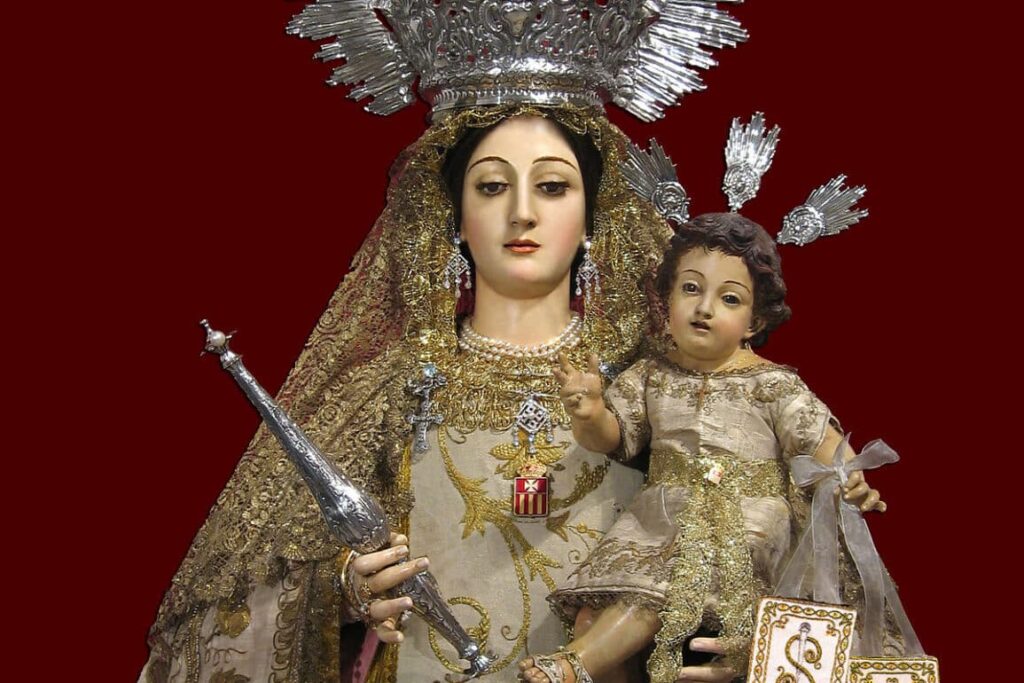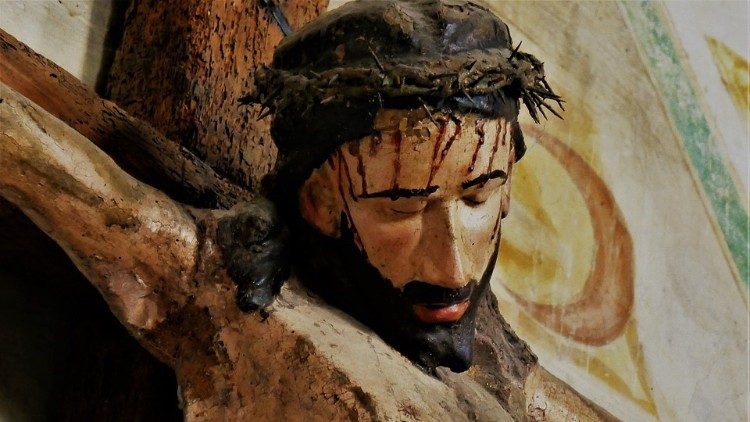Our Lady of Mercy
How did Our Lady of Mercy become the patron saint of Barcelona?

Legend has it that on the night of September 24, 1218, Our Lady appeared simultaneously to King James I, Saint Peter Nolasco and Saint Raymond of Penyafort. She asked all three of them to create an order of monks dedicated to saving Christians imprisoned by the Saracens. These were times of religious war.
Centuries later, in 1687, Barcelona suffered a plague of locusts and placed itself in the hands of Our Lady of Mercy. After the plague was over, the City Council named her patron saint of Barcelona. But the Pope did not ratify the decision until two centuries later, in 1868.
The Carving
The carving of the image of Our Lady of Mercy that is venerated in the Basilica of Our Lady of Mercy in Barcelona is from the 14th century, in a seated style, like the Romanesque ones. In Catalan “Mare de Deu de la Mercé”, Mother of God of Mercy. In 1696, Pope Innocent XII extended the feast of Our Lady of Mercy to the entire Church, and set its date on September 24. But following the liturgical reform of the Second Vatican Council, in 1969 the feast was removed from the universal calendar.
Expansion As early as 1259, long before the “discovery of America”, the devotion to Our Lady of Mercy began to spread throughout the world, which was spread by the “Mercedarian” friars who had assumed the four vows of the order as the center of their devotion to the Virgin: poverty, chastity, obedience and being willing to give themselves and exchange themselves for hostages and give their lives if necessary. It is estimated that around three hundred thousand were redeemed by the Mercedarian friars from captivity by the Muslims, most of them in exchange for money. Around three thousand are the religious who are considered martyrs for dying in fulfillment of their vow. Pedro Nolasco died in 1266, at the age of 77, was canonized and his feast day is celebrated on May 6.
The Mercedarian friars brought their love for the Virgin of Mercy to the American continent, which spread widely. Although it is said that the first mass celebrated on the American continent was celebrated before an image of Mercy, brought on the second trip by Brother Bernard Boïl, hermit of Montserrat, and the Hieronymite hermit of the Monastery of San Jerónimo de la Murtra, Brother Ramon Pané. In the Dominican Republic, Peru, Ecuador, Argentina, Colombia (patron saint of prisoners), Chile, Guatemala, El Salvador and many other countries, Our Lady of Mercy is well known and loved.
Historical legacy The appearance of Our Lady of Mercy leaves us with a historical legacy of how the conquerors imposed their way of organizing society and space. This caused great confusion among members of indigenous cultures who were forced to adopt a new language, another religion, which replaced their multiple gods with one, and even a new family organization that ended polygamy and established monogamy.
The Diocesan Archive has brought to light the documentation that explains how Our Lady of Mercy became the patron saint of Barcelona. It has been discovered that on February 27, 1868, Pope Pius IX gave his authorization, communicated in a letter addressed to the bishop of the time, Pantaleón Montserrat. The letter was preceded by months of negotiations and demands before the Holy See from, among others, the bishopric itself or the city council.
On October 27, 1867, some seventy nobles of the city made “the request” for Our Lady of Mercy to be instituted as the patron saint of the city. The date is not a coincidence. Months before, by papal decree, it was established that in Spanish cities only one patron saint could be had. On November 9, the city council “and the people” of Barcelona sent a letter to the Vatican with this request and the mayor himself, Juan López de Bustamante, began the legal procedures with another official letter to the bishopric of the city on November 18. This writing was sent to the apostolic nuncio in Spain, who forwarded it to Rome.
Vatican Response
The procedure was taken up by the Vatican Congregation for Sacred Rites, which on February 27 informed the Bishop of Barcelona that:
«Having expressed to our most holy lord Pius Pope IX that it would be very pleasing to the faithful entrusted to your pastoral care that the feast of the Blessed Virgin Mary of Mercy be established as Patronal for this your diocese, His Holiness, having made a report of these vows by the undersigned Secretary of the Congregation for Sacred Rites, and mercifully deferring them, established the feast of the Most Holy Virgin Mary of Mercy, which falls on September 24, as Patronal for the Bishopric of Barcelona; and ordered that the same feast be celebrated under the double rite of the first class, octave and under the double precept, namely, to hear Mass and abstain from servile work.
By communicating to Your Excellency the concession of His Holiness, I ardently wish you a long happiness.
From V.S.E. In Rome on February 27, 1868.
(Signature) As Brother C. Bishop of Porto and Santa Rufina, Cardinal Patrizi, Prefect of the Congregation of Sacred Rites.»
However, the bishopric of Barcelona took a while to make it official, since in the following months they tried to have the two patrons of the city, in addition to La Merced; Santa Eulàlia and San Sever (who were also the object of much devotion of the people of Barcelona) maintain this condition. However, the Congregation of Sacred Rites, adhering to the papal decree of 1867, denied the request. It was not until June that the change of patron saint was legally made with the required permission of Queen Isabel II.
Related

THE WAY OF THE CROSS: Accompanying Jesus on the way to the Cross
Luis Herrera Campo
31 March, 2025
5 min

Mother Carmen Rendiles, the first Venezuelan saint proclaimed by the Universal Catholic Church
Exaudi Staff
31 March, 2025
3 min

The International Academy of Catholic Leaders: Renewal and Commitment to its Mission
Exaudi Staff
30 March, 2025
4 min

Reflection by Bishop Enrique Díaz: The Heart of the Father
Enrique Díaz
30 March, 2025
5 min
 (EN)
(EN)
 (ES)
(ES)
 (IT)
(IT)

